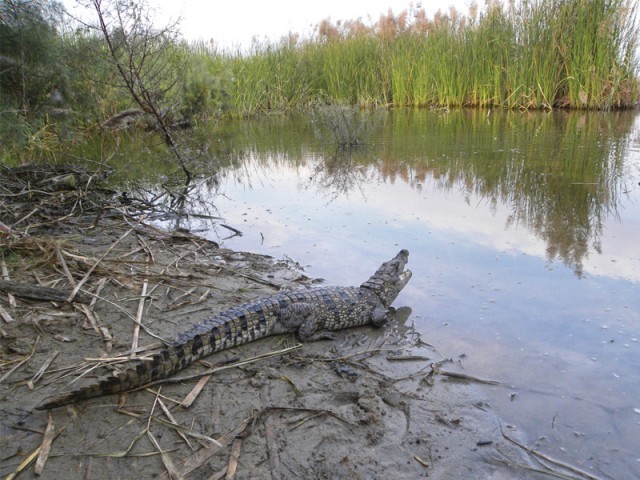Long under attack from poachers for their skin, fashioned into bags, shoes and the like, marsh crocodiles in Pakistan’s scenic Nara wetland complex in Sindh province have found a safe refuge with international pressure combining with a ban on hunting. In a happy tale of survival and revival, the crocodile population in the Nara and Deh Akro sanctuaries is estimated to have gone up to over 4,000.
This is just an estimate and there has been no fresh survey, says Sindh Wildlife Department (SWD) Deputy Conservator Ghulam Mohammed Gadani, adding that the government is planning to extend the Deh Akro sanctuary by declaring some lakes as breeding grounds.
But in a remarkable achievement, not a single crocodile has been poached for commercial purposes in the last seven-eight years from the Chotiari reserve or the Nara canal area that comprise the wetland area, which stretches from the Rahimyar Khan desert in Punjab up to Sanghar district in Sindh. The Nara canal, which is a flood channel of the Indus, is the longest canal in Pakistan, running for 364 km. It has been the natural feeding source of desert area wetlands—Nara and Deh Akro.
The Nara valley, known as a wetland complex of about 225 small and large lakes, is one of the natural habitats for marsh crocodiles (Crocodulus palustris). The canal area, which includes about 200 lakes and marshes, is a great refuge for crocodiles and other wildlife. The entire wetland complex is renowned for being home to otters, fresh water turtles, Indian pythons, chameleon hog dear and nilgai. Its ecological health is crucial for the downstream stretches of the transboundary Indus basin.
Moula Bakhsh Mallah, a community elder from Bakar village in Sanghar, is among those who welcome the initiatives that have led to the increase in the numbers of the crocodile. “Now crocodiles are safe from hunters and poachers at its natural habitat, the Nara complex,” he said.
There are 23 living species of the order Crocodilia in the world. Marsh crocodiles inhabit the entire Nara canal and its tributaries, Jamrao, Mithrao and Khipro, which were originally part of the Indus river system and fed lakes and farm lands.
But if one species has survived and regenerated, another has not. The other crocodile species in the area, the gharial (Gavialis gangeticus), was seen till 1978 in the Indus but is virtually extinct with no reports of sightings since. This is attributed mainly to the receding waters of the river as the gharial can survive only in fresh waters.
There is a flip side to the marsh crocodile story too. Though poaching is under control, the gradual depletion of habitat means that crocodiles often stray into private fish farms in search of food and are attacked by farmers. According to Nehal Mallah, a game watcher of the SWD, farm owners trace crocodile tracks and attack the reptiles with guns as their fish stock is eaten up. “Except for some greedy people, fishermen do not kill or poach crocodiles just for the sake of it. They love otters, crocodiles and fresh water turtles.”
Recently, for instance, two crocodiles were killed but the costly skin was left intact. It is a telling example of how things have changed from the past. Local fishermen recall how parliamentarians would set up overnight camps, play music the entire night and target crocodiles when they came out of hiding as the sun rose. Now it seems, neither do traders offer money to hunters for killing reptiles nor do the rich and powerful travel to the isolated lakes for fun – the reason perhaps why numbers are growing.
The Pakistan government, a signatory to the Convention on International Trade in Endangered Species (CITES), has been under attack for not implementing the rules strictly enough. Just being a signatory is never enough, say experts. What has made a difference is that traders, manufacturers and exporters are now reluctant to offer incentives for poaching animals due to the fear of being exposed. Social media has played a role too in increasing awareness. And so do traditions and rituals.
Saleem Chang, who has done his PhD on Inheritance and Reproductive Role of Rare Males in Parthenogenetic Population at the Ocean University of China, believes that crocodiles are under threat from habitat loss, hunting, water scarcity and other anthropogenic activities. The reptiles could be protected through developing a captive breeding programme, the researcher has said, citing the Manghopir shrine in the Sindh capital Karachi where people worship crocodiles inhabiting a pond. Devotees travel from different parts of Pakistan’s Sindh and Balochistan provinces to take part in generations-old rituals to pay tribute to the crocodiles.
“We are developing linkages within the communities to protect the species and avoid hunting and poaching,” said Ishaq Mangrio, president of the Centre for Rural Change (CRC), which is implementing a community-led conservation of the marsh crocodile in Nara with the support of the UNDP-GEF Small Grants Programme.
He would also like to explore the option of setting up community-led breeding grounds for crocodiles, the natural custodians of waters and wildlife. This could be achieved only by removing misconceptions of the people and through the government’s political will to protect the animal, Mangrio added.

